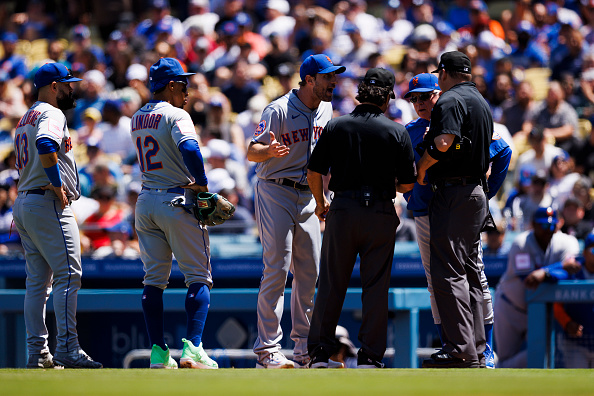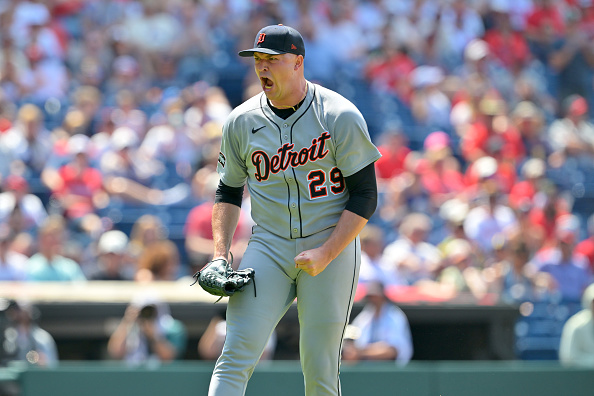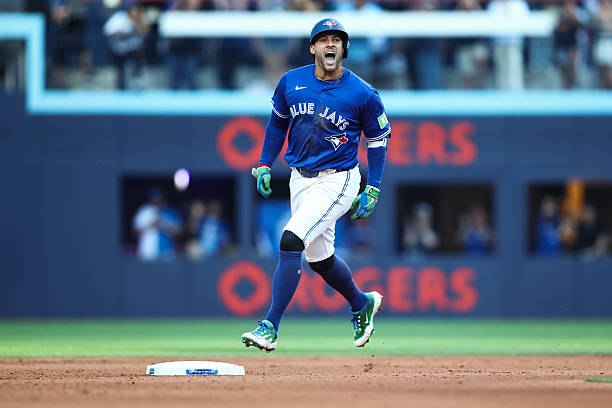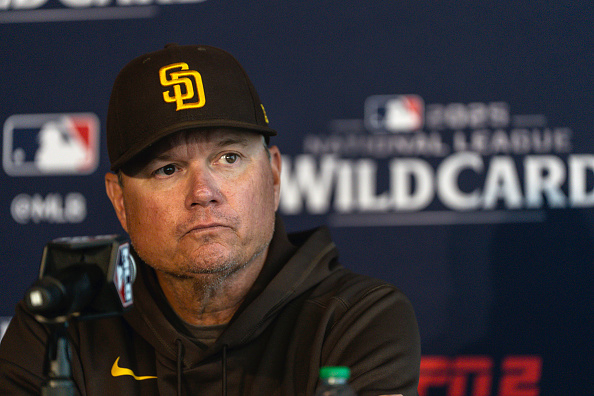The ejection of Max Scherzer is re-igniting the conversation dealing with rosin, sticky substances, and even about how pitchers can attach the Pitch Com device to themselves, their uniforms, or their gloves. The umpires checked Scherzer prior to the third inning, which resulted in the umpire forcing Scherzer to switch gloves. Then, prior to the fourth inning, home plate umpire Dan Bellino and first-base umpire Phil Cuzzi approached Scherzer to check him again. Upon checking Scherzer, Bellino pointed at and touched Scherzer’s throwing hand. Extremely animated, Scherzer seemingly responded to Bellino’s statements with: “Right. It’s rosin. I know. It’s rosin. I promise you on my life– I promise you!” The conversation between the umpires and Scherzer continued for a short time. Then Cuzzi, while still holding and looking at the glove, shook his head and threw Scherzer out of the game.
Tossing Max Scherzer for possibly having a sticky substance after how adamant he was about not using any when the league first introduced sticky checks is quite the plot twist. pic.twitter.com/yZTCGnCJnO
— Jared Carrabis (@Jared_Carrabis) April 19, 2023
Here is another angle of the Max Scherzer rosin conversation with the umpires and subsequent ejection:
Scherzer Ejection.
“It’s Rosin” pic.twitter.com/6o3MGu21PI
— Rob Friedman (@PitchingNinja) April 19, 2023
Pitch Com
Some fans on Twitter mentioned that there was also an issue with the taping of the Pitch Com inside Scherzer’s glove or to the back of his hand. We are unable to verify this and Scherzer did not mention anything like that after the game. Tape is a sticky substance that MLB actually mentions in the rule’s definition as disallowed, which is why pitchers never have their hands or wrists taped while pitching in a game.
A Prior Animated Max Scherzer Sticky Substance Check
Embed from Getty Images
This is not the first time Scherzer has had a problem with sticky substance checks. In 2021, during a game between the Washington Nationals and Philadelphia Phillies, Second-base umpire Alfonso Marquez checked Scherzer twice– once after the first and again after the third inning. Then Phillies manager Joe Girardi saw Scherzer touch his hair and requested that the umpires check Scherzer a third time. When checked for the third time, a frustrated and very animated Scherzer threw his glove to the ground and began unbuckling his belt as shown in the video contained within the following tweet:
Max Scherzer just got checked again for a foreign substance in the middle of the 4th inning pic.twitter.com/2OGbi6Lh12
— Kev (@OnePursuitTakes) June 23, 2021
Embed from Getty Images
Alfonso Marquez was not an umpire in Wednesday’s contest but some have taken issue with Phil Cuzzi. Since MLB began checking pitchers for sticky substances in 2021, there have been only three ejections– and Cuzzi was involved with each ejection. Further, Domingo German seemed to be caught using sticky substances on Wednesday, but the umpire in that game only had German wash his hands before re-entering the game. Fans are on Cuzzi for being the only umpire to eject anyone under this rule and for ejecting Scherzer when a Yankees player washed his hand and did not receive an ejection on the same day. But should Cuzzi be the scapegoat? The case can be made that he is the only umpire to actually follow the rule. The rule is as follows:
“Doctoring the Baseball” MLB Rule Definition
“No player is permitted to intentionally damage, deface or discolor the baseball by rubbing it with any type of foreign item or substance, including dirt or saliva. Failure to follow this rule will result in an ejection and an automatic 10-game suspension.The pitcher is allowed to rub the ball between his bare hands but cannot spit on the ball, his hands or his glove. Also, pitchers are not allowed to rub the ball on their clothes, glove or other body parts besides their hands, nor are they permitted to pitch with an attachment such as a bandage, tape or bracelet on either hand or wrist.While in contact with the pitching rubber, the pitcher is not allowed to touch his mouth or lips at all. He can touch his mouth or lips when in the 18-foot circle surrounding the pitching rubber, but he is not permitted to then touch the baseball or the pitching rubber without first wiping his pitching hand dry. The pitcher shall be issued a warning the first time he violates this rule and then the umpire shall call an automatic ball for each subsequent violation. The pitcher may be allowed to blow on his pitching hand in a game played in cold weather, provided both managers agree to that exception prior to the start of the game.” – from the MLB Rules Glossary
Ejection Versus Suspension
Notice how the definition distinguishes between rubbing the ball with a foreign substance, which requires ejection and suspension, from when a pitcher touches his mouth or lips while on the pitching rubber, which requires a warning. One calls for ejection while the other calls for a warning. The rules are clear here and if MLB wanted to provide pitchers with a warning for using sticky substances, then they not only could have put it in the definition but would have. After all, they specifically state two separate punishments for two separate violations within the scope of one rule’s definition. But even with this argument, we must acknowledge that umpires provided Scherzer with a warning. The umpire made Scherzer switch gloves in an attempt to resolve the dispute with a warning. One cannot avoid or ignore this fact. Both German and Scherzer were provided with a warning.
The umpire is following the rules in terms of the ejection– and only violated the rules by providing Scherzer with an option to change gloves prior to ejecting him. Don’t blame Cuzzi; he gave Scherzer a chance to fix things. Umpires are not provided with an on-the-spot preliminary substance test like police officers. If they were, they may be able to test for rosin and sweat versus disallowed substances, but that would seem to be a ludicrous option and is only offered here to show that umpires don’t have much guidance on how to find sticky substances. Umpires are left to their opinions and judgments.
What’s Wrong With the Max Scherzer Rosin Ejection
So should we villainize umpires for their opinions when that is what MLB offered us in the rules? No. People ought to vilify the rules that are problematic as opposed to the umpires, who are trying to do their jobs by following the rules. Cuzzi even bent the rule for Scherzer by allowing him to swap gloves prior to his ejection and Scherzer claims he washed his hands in front of an MLB official prior to the ejection.
But, there is another point to make here. Scherzer maintains that the sticky substance was rosin, which is freely provided to pitchers and generally placed on the back of the pitcher’s mound. If umpires are left to their opinions, and rosin is provided freely, then the umpires ought to learn the difference between the stickiness that can be added through the combination of sweat and rosin versus the stickiness that can be added from other substances sometimes illegally added to rosin, like sunscreen. Do the MLB umpires get training where they are tested on their ability to spot substances other than rosin?
Potential Training of MLB Umpires
Perhaps there should be some hands-on training during the spring where they practice checking someone’s hand who has applied different substances to it. Umpires shouldn’t need to define the substance on the person’s hand but only point out which one, or ones are illegal. They should be tested on their ability to spot whether or not a hand has illegal substance(s) on it. MLB should drill them on it. The players run drills and practice in spring training to help them fix mistakes so that they don’t happen during a game. The umpires should do the same thing with sticky substances.
One other interesting point to make is that the rosin bag provided to players generally rests on the back of the dirt mound. MLB specifically names dirt as an illegal substance. Players cannot rub dirt onto the ball. So why is the rosin bag frequently resting on the dirt? Can the rosin bag not become dirty and therefore cause pitchers to rub dirt into the ball with the rosin? That makes little sense to this writer. Perhaps the rosin bag is meant to be stored on the infield grass. I offer this suggestion in an attempt to provide the league with the benefit of the doubt on this matter.
Max Scherzer Explains His Rosin Ejection
Max Scherzer provides a detailed explanation on today’s events, explaining how he feels that he should not have been ejected: pic.twitter.com/MMPDTcguVk
— SNY (@SNYtv) April 19, 2023
If what Scherzer described after the game happened, in the above video, then something certainly needs to change. Scherzer described the umpire as having a problem with the rosin on his hand, which had clumped up due to his sweat. Scherzer said he washed his hand off with alcohol in front of the official, then applied rosin and sweat to his hand. He says that he knew he was about to be checked again for the fourth inning and “would have to be an absolute idiot to try to do anything” when coming out for the fourth.
When he did come out for the fourth inning, Cuzzi told Scherzer his hand was still too sticky. Everyone saw what happened next: an animated Scherzer thrown out of the game over rosin. “I don’t get it- yes, when you use sweat and rosin, your hand is sticky,” said Scherzer after the game. “But I don’t get how I get ejected when I’m in front of MLB officials doing exactly– exactly what you want and being deemed that my hand is too sticky when I’m using (a) legal substance. I do not understand that,” Scherzer continued.
If Scherzer washed his hand off with alcohol in front of an MLB official, and he still received an ejection, then there is a problem. The situation warranted the animated outrage that Scherzer displayed immediately before his ejection. If this is what took place, then it’s probably impossible to find a single pitcher that would not feel outraged had this happened to them.
MLB’s Continuing Problem
There are a couple of possible solutions people have provided. One solution is to allow pitchers to use sticky substances. The other is to disallow pitchers the use of rosin. Both solutions are extreme and lazy in their own right. What lazy means here is that although the solution is simple and straightforward, something better is possible. If you recall, the problem that made MLB want to check pitchers during the game is that many pitchers were using sticky substances, and a player by the name of Trevor Bauer was vocal about it. Bauer stated he could increase his spin rate by a specific amount by using an illegal substance. MLB didn’t do anything to solve the problem and then, suddenly, Bauer’s spin rate began to increase by about the same amount he stated it would increase if he applied an illegal substance to his fingers.
Embed from Getty Images
Not only did MLB still do nothing, but Bauer won the Cy Young Award as a result of his use of the substance. It was a direct slap in the face to MLB and MLB took it as if Bauer removed his glove prior to slapping them in order to challenge them to a duel. Bauer was subsequently return-slapped with the longest suspension in MLB history for sexual acts that he was accused of, but not arrested for nor charged with – to which a California judge referred to as “materially misleading” prior to dismissing outright – and now he no longer plays baseball in the United States. The suspension was so long that an arbiter had to reduce his suspension by 1/3 because it was so egregious. Many agreed with the suspension, however.
The Purpose of the Rule
Now we have MLB ejecting and suspending a player accused of using a legal substance in an illegal way. Is that what MLB created the rule to achieve? No. They wanted to level the playing field and offer one legal substance to every pitcher. But MLB has a grey area where that one legal substance sometimes is illegal and umpires eject some people for it on some occasions while not ejecting them for it on other occasions. The common denominator for ejected players is Phil Cuzzi. In this sense, Cuzzi is the one bringing the grey area to the forefront– and apologies to Scherzer, but it’s not necessarily a bad thing that this took place. There’s an obvious problem and MLB ought to fix it.
Cuzzi and Scherzer Are Both Right
As long as Cuzzi maintains impartiality – meaning he keeps his reasoning on the ejections the same and ejects players when they have exceeded a set maximum amount of stickiness – then he is doing the right thing. Nobody said Cuzzi watched Scherzer wash his hand off with alcohol. Cuzzi was using his judgment on the stickiness of Scherzer’s hand because he has no other guidance to go by, thus doing his job. In other words, it seems like both Scherzer and Cuzzi are in the right on this. But, at the same time, all other umpires need to join in with a set standard.
Embed from Getty Images
What is Scherzer supposed to do the next time he pitches– make a guess on how sticky his hand can be for his next start? The umpires need to all throw people out for the same stickiness if they’re going to throw anyone out at all for it. That’s what we call a set standard and MLB needs a standard of stickiness for player ejections. If pitchers knew the standard of stickiness, then they would be able to follow that standard. But when MLB provides rosin and then ejects players for using it after the player followed all guidelines directly from an MLB official, then we have a problem.
MLB Should Learn a Lesson From PEDs
Look at how MLB handles PEDs after being provided with a wake-up call by Congress. MLB now has standardized testing, lists every banned substance for all players, and tests players for those banned substances. When a player tests negative, all they can really do is attempt to justify their use of that substance. It is rare that a player files for, and wins an appeal when caught with a banned substance in their system– Ryan Braun comes to mind. But the point is that there is a set standard and above all else the players know what they can and cannot do. MLB needs a wake-up call on sticky substances to provide players with the knowledge of what they can and cannot do.
Rather than going by the judgment of the umpire, MLB should create a standardized test to determine stickiness. I believe I heard this somewhere previously, but what if MLB were to use some sort of a tissue or a square of toilet paper to press against the pitcher’s fingers where, if the paper sticks to the fingers enough to tear the tissue, then it’s an ejection? MLB needs only to find an appropriate paper to use. MLB can store the type of paper used for the test in dugouts for pitchers to test themselves in between innings or before the game. Players that do this frequently would become used to, and ultimately learn the maximum stickiness without the use of the paper to test.
Whatever they decide, MLB needs to do this better. If the players and fans have to deal with this crap, the least the league can do is provide everyone with a little toilet paper.
More General Baseball Articles
More MLB Articles
Main Photo:
Embed from Getty Images
- Category
-
General Baseball





